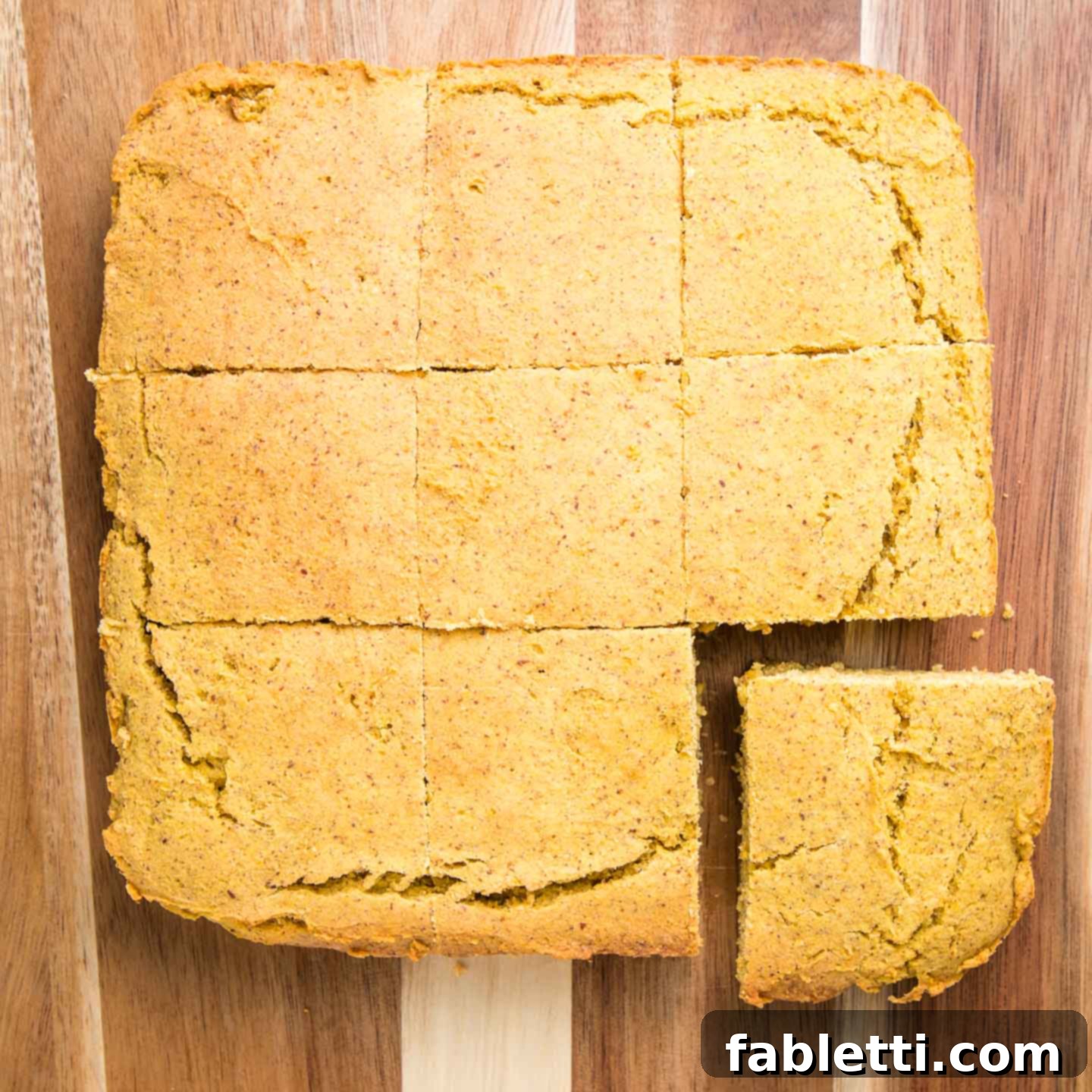The Ultimate Guide to Incredibly Moist Gluten-Free Vegan Cornbread (No Eggs, No Dairy!)
Prepare to rediscover cornbread like never before! This revolutionary oven-baked Gluten-Free Vegan Cornbread defies expectations by using puréed corn kernels to achieve an unparalleled moist texture and perfect structural integrity. Forget dry, crumbly cornbread; this recipe delivers a wonderfully tender, flavorful loaf that holds its shape beautifully. Simply blend a few ingredients, mix in a bowl, pop it into the oven, and in no time, you’ll be enjoying delicious, homemade cornbread completely free from dairy, eggs, and refined sugars.

This isn’t just a recipe; it’s a transformation of the classic cornbread many grew up with, meticulously updated for modern dietary needs without sacrificing an ounce of flavor or texture. Imagine your Grandma’s comforting cornbread, but now reimagined to be entirely eggless and free from refined sugar. It boasts that traditional cornbread taste and texture – perfectly crumbly yet supremely moist – ensuring every bite is a delightful experience. Whether you follow a gluten-free or vegan lifestyle, or simply seek healthier alternatives, this cornbread is a game-changer.
Why This Gluten-Free Vegan Cornbread Stands Out
What makes this gluten-free vegan cornbread truly exceptional? The secret lies in one simple, natural ingredient: puréed corn kernels. Unlike many vegan cornbread recipes that can sometimes struggle with dryness or a gummy texture due to the absence of eggs, our innovative approach incorporates actual corn, blended into a smooth mixture. This not only enhances the natural corn flavor but also provides essential moisture and acts as a binder, eliminating the need for eggs or excessive oil. The result is a cornbread that is incredibly moist, tender, and robust enough to hold its shape, making it ideal for slicing, crumbling, or dipping.
Furthermore, this recipe caters to conscious eating by being completely dairy-free, egg-free, and sweetened without refined sugars. We utilize maple syrup as a natural sweetener, offering a subtle sweetness that complements the savory corn flavor beautifully. This thoughtful combination of ingredients ensures a wholesome and delicious baked good that everyone can enjoy, regardless of dietary restrictions. It’s a comforting, versatile bread that truly brings the best of traditional flavors into a healthy, modern context.
Versatile Serving Suggestions for Your Vegan Cornbread
This remarkable gluten-free vegan cornbread is incredibly versatile and can elevate any meal. Its robust flavor and moist texture make it a fantastic companion for a variety of dishes. Here are some of our favorite ways to enjoy it:
- Hearty Chili and Soups: It’s the perfect absorbent side for soaking up rich, flavorful broths. Serve it alongside a steaming bowl of meatless chili or a comforting hearty lentil soup. The cornbread’s subtle sweetness provides a wonderful contrast to savory stews.
- Thanksgiving Feasts: Don’t let dietary needs stop you from enjoying holiday traditions! This cornbread is excellent for preparing a delicious Gluten-free Cornbread Stuffing, adding a unique and flavorful twist to your Thanksgiving spread.
- Game Day Buffets: Make your next gathering a hit by adding this cornbread to your snack spread. It’s a crowd-pleaser that’s easy to prepare and serve, pairing well with dips or as a simple, satisfying bite.
- Breakfast or Snack: Enjoy a slice warmed with a drizzle of extra maple syrup or a dollop of vegan butter for a simple, satisfying breakfast or a delightful afternoon snack. Its natural sweetness and filling texture make it a great grab-and-go option.
- Barbecue Sides: Complement your plant-based barbecue with a side of this cornbread. Its slightly sweet and savory profile makes it an ideal accompaniment to grilled vegetables, vegan burgers, or smoky baked beans.
From casual weeknight dinners to festive holiday gatherings, this cornbread is sure to become a staple in your kitchen, celebrated for its adaptability and deliciousness.
Essential Ingredients for the Perfect Vegan Cornbread
Crafting the perfect gluten-free vegan cornbread starts with a selection of high-quality ingredients, each playing a crucial role in achieving its signature moist texture and delightful flavor. Here’s a closer look at what you’ll need and why:
- Corn: Yes, actual corn is the star! For the best results, use frozen corn kernels, ensuring they are fully defrosted before use. Frozen corn typically offers a fresher, sweeter flavor profile and better texture compared to canned corn, which can sometimes be overly processed or contain added sodium. The puréed corn is the secret to our cornbread’s incredible moisture and acts as a natural binder, eliminating the need for eggs.
- Cornmeal: This provides the classic grainy texture and authentic corn flavor. For a more rustic feel and added depth, stone-ground cornmeal is an excellent choice. However, if fine-ground cornmeal is what you have on hand, it will still yield a delicious loaf with a slightly smoother texture. Look for non-GMO options if available.
- Flour: The beauty of this recipe is its adaptability. You can use your preferred all-purpose flour blend. In the recipe photos, King Arthur Gluten-Free Measure-for-Measure Flour was used, yielding a beautifully textured and tasting cornbread. Other excellent gluten-free options include a good quality 1-to-1 gluten-free baking blend or cassava flour. If gluten isn’t an issue, sprouted spelt flour or whole wheat flour can also be used, lending a slightly nutty flavor and denser texture. The key is to use a flour you know you tolerate well.
- Ground Flaxseed (Flaxmeal): This is your vegan binder extraordinaire! When combined with liquid, ground flaxseed creates a gelatinous mixture known as a “flax egg,” which effectively replaces traditional eggs, helping the cornbread hold together and providing structure. If you don’t have ground flax, you can substitute with ground chia seeds, ensuring they are finely ground before use to achieve the same binding consistency.
- Maple Syrup: Our preferred natural sweetener, maple syrup offers a rich, distinctive flavor that complements the corn. If you consume honey, it makes a fine substitute. For those who prefer a less sweet cornbread, the initial ¼ cup is sufficient. If you crave a sweeter profile, feel free to add an extra 1-2 tablespoons. You can also explore agave nectar for a similar sweetening effect.
- Apple Cider Vinegar: This acidic ingredient is crucial for activating the baking soda in the recipe, contributing to the cornbread’s rise and light texture. In combination with the ground flax, it also enhances the binding properties, ensuring a perfectly structured loaf. Don’t worry, the vinegar flavor bakes out, leaving no discernible taste in the final product.
- Olive Oil: A good quality olive oil adds richness and further enhances the moistness of the cornbread. You can also use other neutral-flavored oils like avocado oil. For an oil-free version, see our notes below for adjustments.
- Baking Powder & Baking Soda: These leavening agents work in harmony with the apple cider vinegar to create a light and airy texture, giving the cornbread its characteristic rise.
- Salt: A touch of coarse sea salt balances the sweetness and brings out the full flavor of the corn.
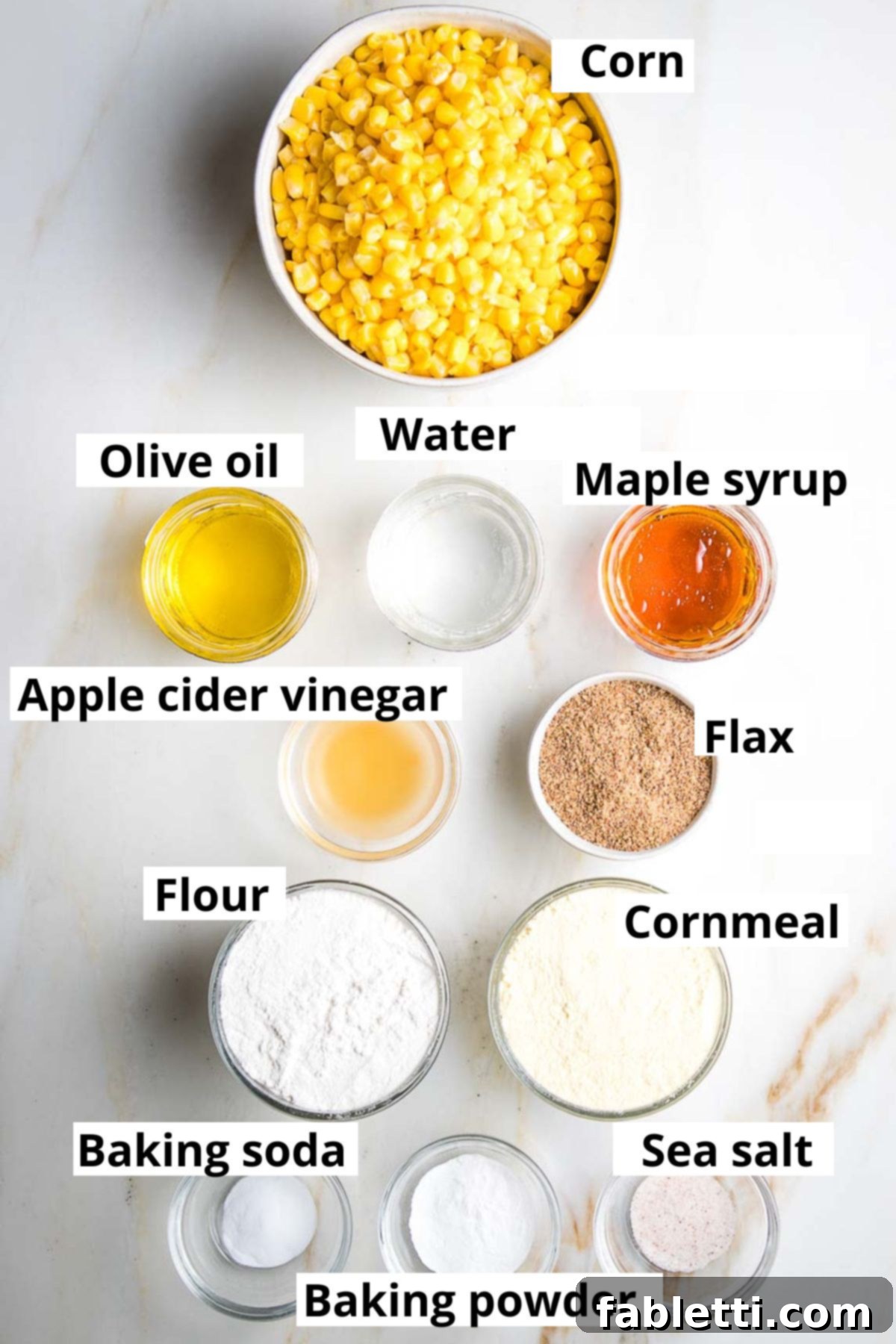
Step-by-Step Guide: Crafting Your Perfect Cornbread
Making this incredibly moist gluten-free vegan cornbread is surprisingly simple. Follow these steps for a delicious result:

Step 1: Prepare the Corn Base. Begin by placing your defrosted frozen corn kernels, along with water and olive oil, into the pitcher of a blender or the bowl of a food processor. This simple hack of blending corn with water and oil provides the perfect moist texture, brilliantly replacing the need for eggs and butter in traditional cornbread recipes. For an oil-free option, refer to the notes in the full recipe card.

Step 2: Achieve Smoothness. Blend the corn mixture until the corn kernels have completely broken down into a smooth, thick consistency. Ensure there are no large chunks remaining; the key to a uniformly moist cornbread is a well-blended base. This puréed corn provides the foundational moisture and structure for your vegan cornbread.
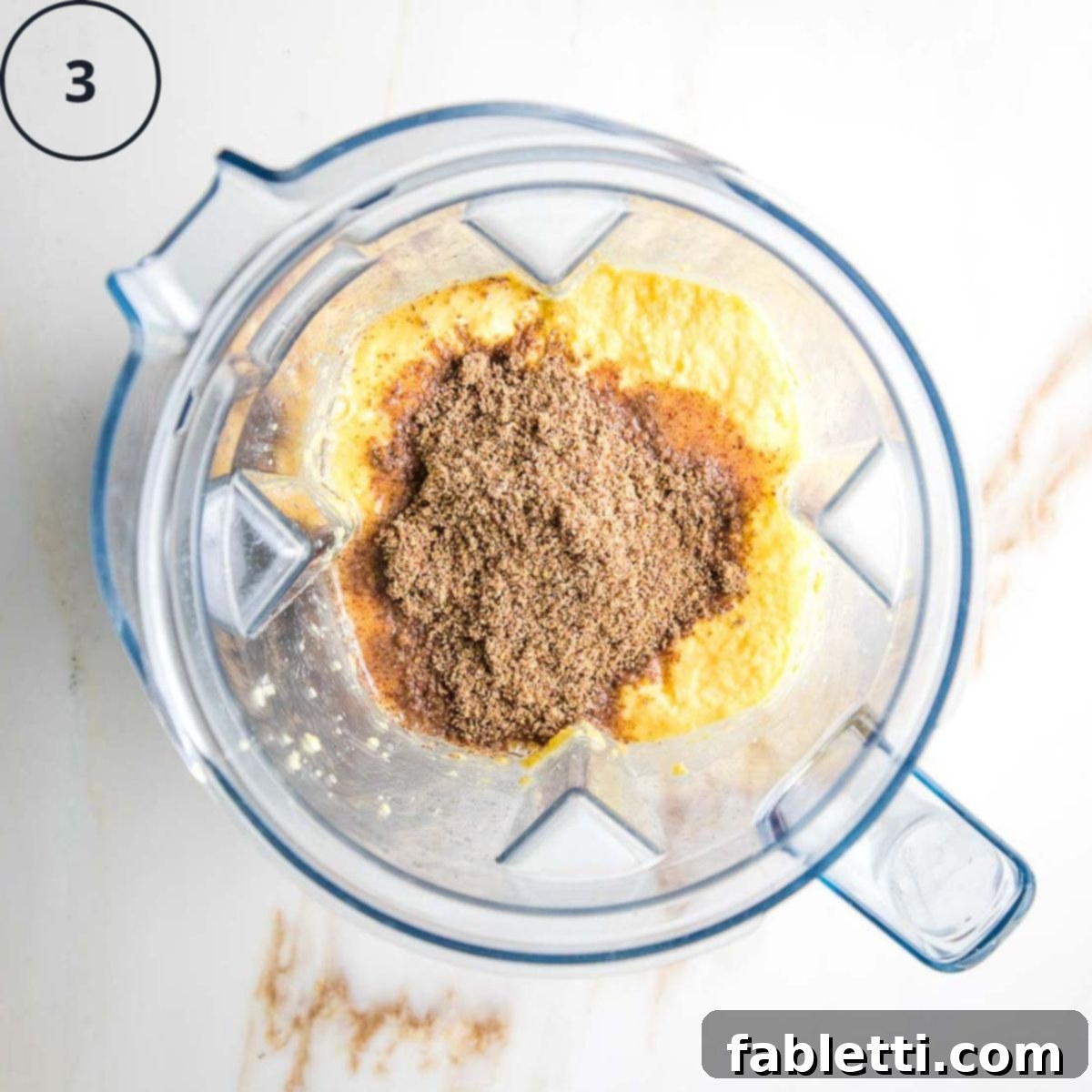
Step 3: Add Binders and Sweetener. Now, introduce the apple cider vinegar and ground flaxseed to the blender. These ingredients are vital for binding the cornbread and helping it rise, ensuring the texture you expect from a traditional loaf. Next, add the maple syrup. For a subtle sweetness that balances the corn, ¼ cup is usually sufficient. If you prefer a sweeter cornbread, feel free to add an extra 1-2 tablespoons of maple syrup or honey to taste.
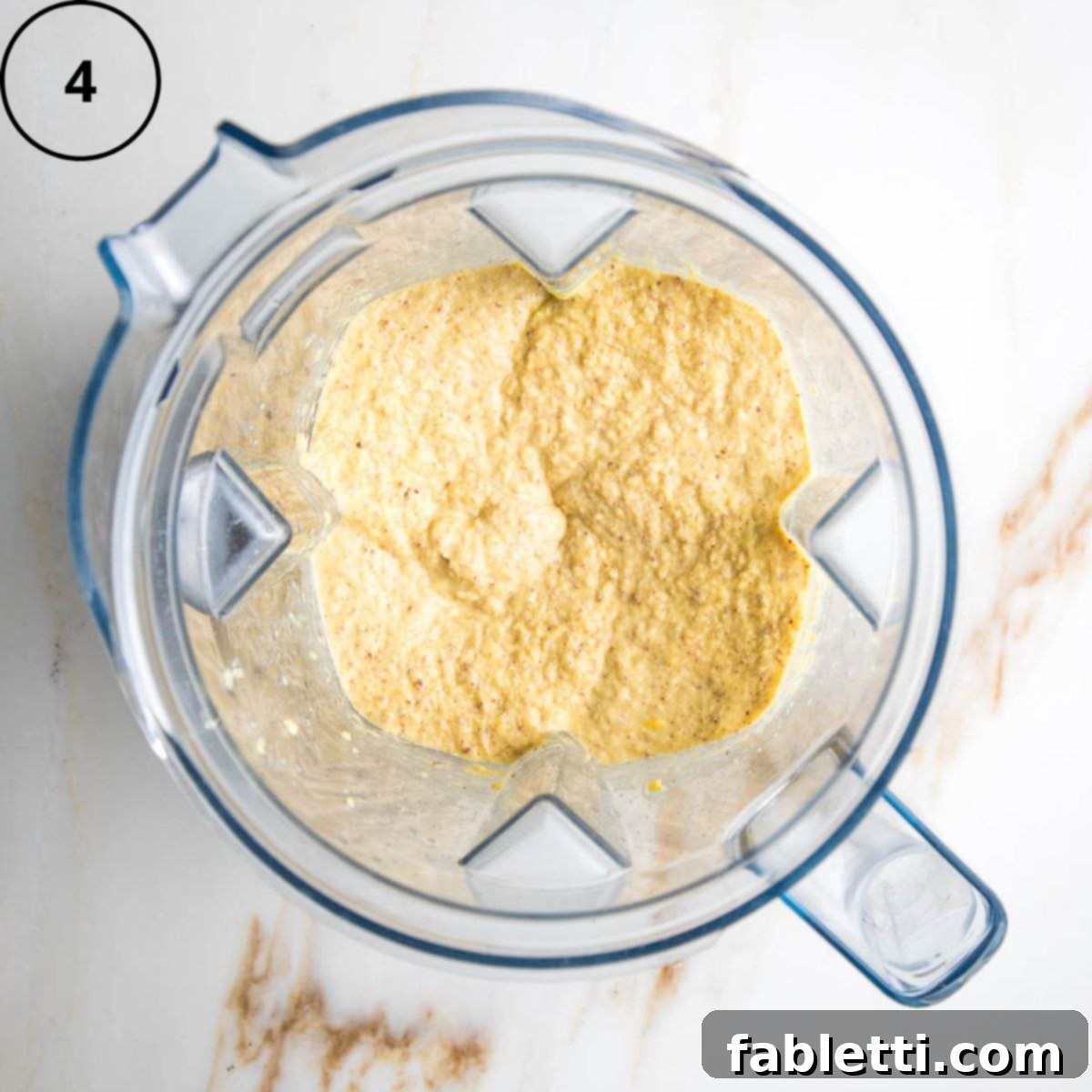
Step 4: Blend and Rest. Blend all the wet ingredients together until they are thoroughly incorporated and smooth. Once blended, let the mixture sit for about 10 minutes. This resting period allows the ground flaxseed to absorb moisture and create its binding gel, which is crucial for the cornbread’s structure. Use this time efficiently to preheat your oven, prepare your baking pan, and gather your dry ingredients.

Step 5: Combine Dry Ingredients. In a separate large mixing bowl, whisk together your gluten-free flour, cornmeal, baking powder, baking soda, and salt. Ensure these ingredients are thoroughly combined to distribute the leavening agents evenly, which will help your cornbread rise uniformly.

Step 6: Gently Mix Wet and Dry. Pour the blended wet corn mixture into the bowl containing your dry ingredients. Mix everything by hand until they are just combined. It is crucial not to overmix the batter. Overmixing can develop the gluten (even in gluten-free flours) or activate starches too much, leading to a tough or dry cornbread. Stir just until no streaks of dry flour remain, making sure to scrape the bottom of the bowl to incorporate all ingredients. The batter will be noticeably thick and pasty.
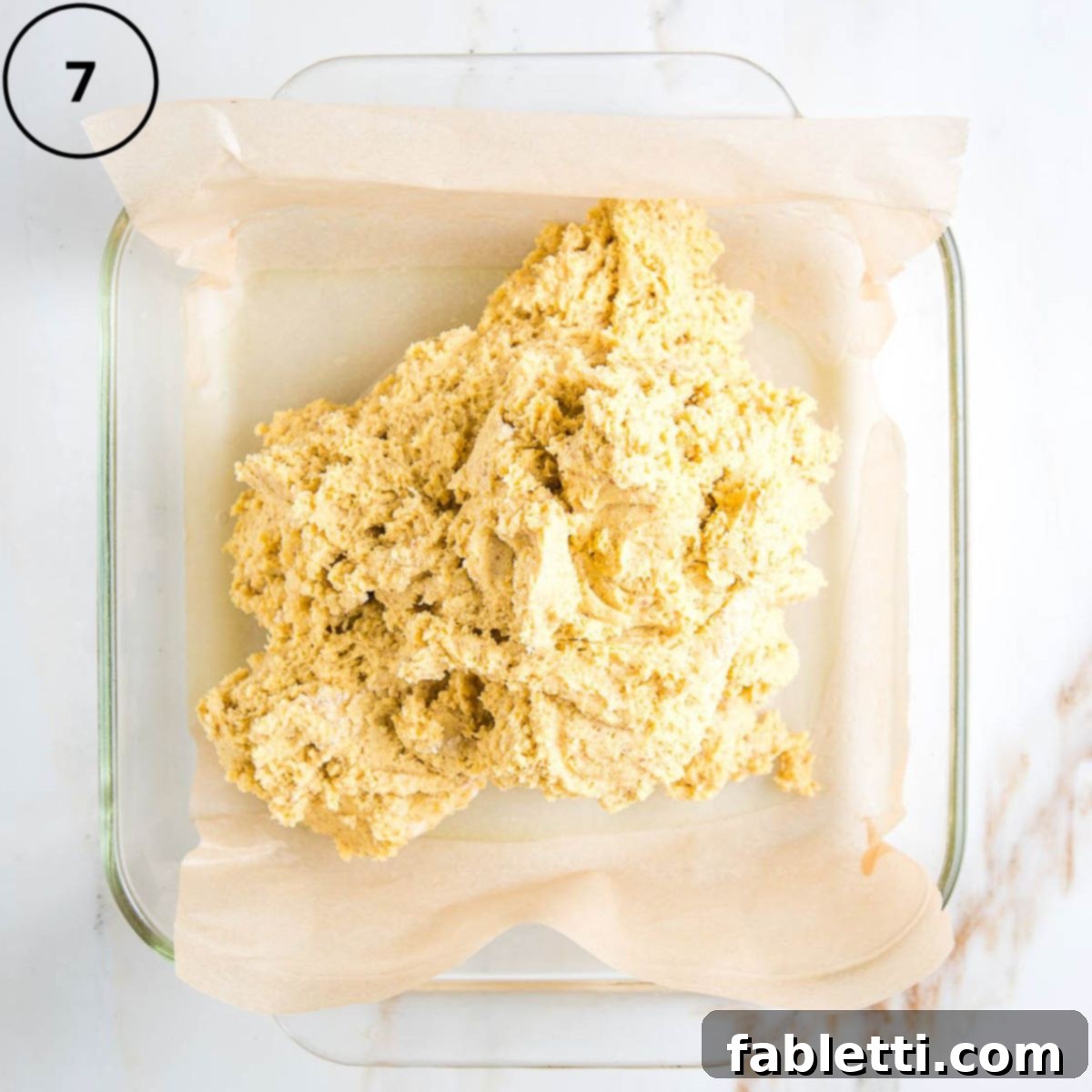
Step 7: Prepare for Baking. Transfer the thick cornbread batter into your prepared pan. You can use an 8×8-inch square pan, ideally lined with unbleached parchment paper for easy removal. Alternatively, for a delightfully crispy edge, use a preheated cast iron skillet, thoroughly greased with olive oil. Place the cast iron skillet in the oven while it preheats to ensure it’s piping hot when the batter goes in.

Step 8: Smooth the Batter. Use an offset spatula or the back of a spoon to spread the thick batter evenly into the prepared pan. This ensures uniform baking and a beautiful, consistent loaf.

Step 9: Bake to Perfection. Bake your cornbread in the preheated 375°F (190°C) oven for approximately 35 minutes. The cornbread is ready when a toothpick inserted into the center comes out clean, and the top is golden brown with appealing cracks. Depending on your oven, it might need an extra 3-5 minutes, so keep an eye on it.
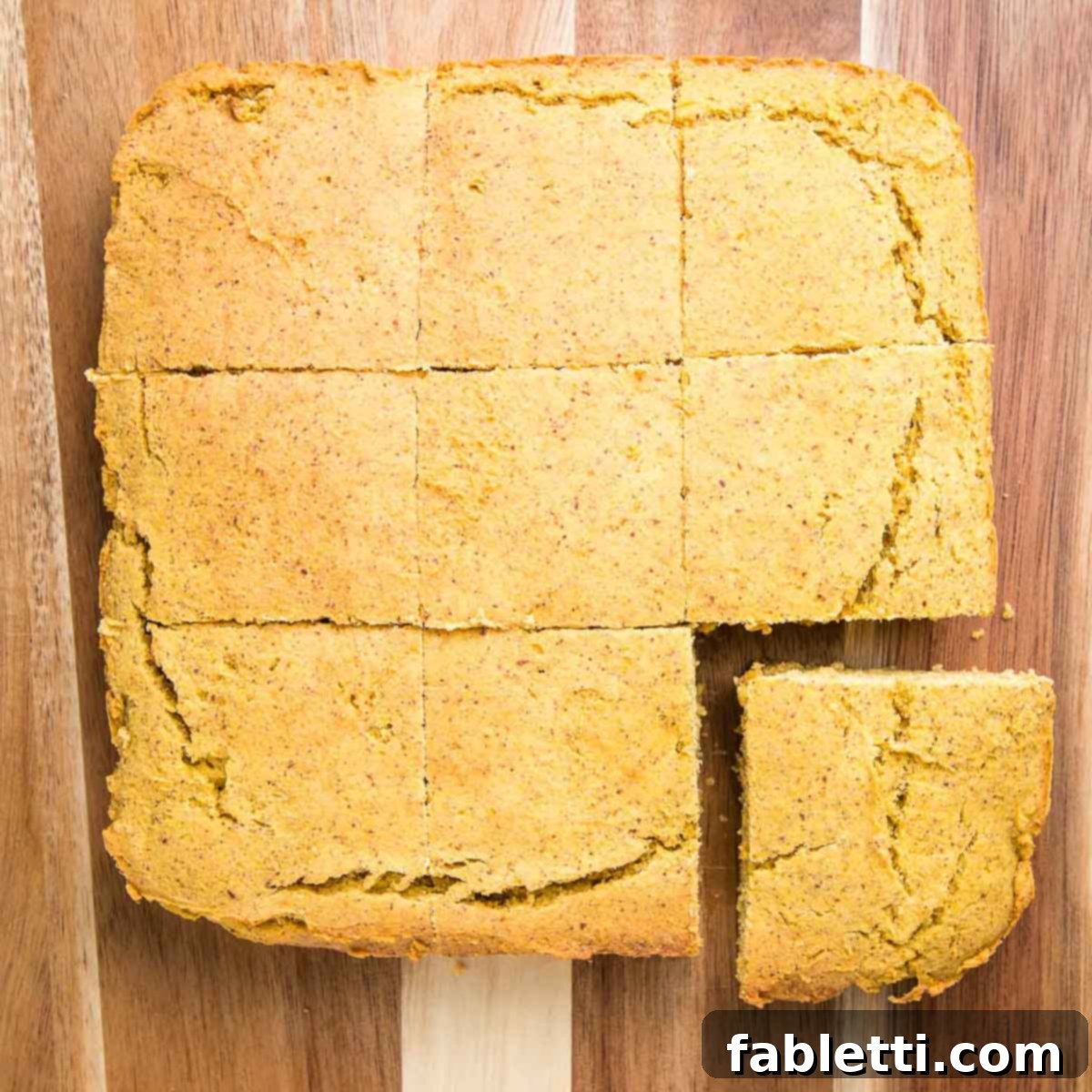
Step 10: Cool and Enjoy. Once baked, remove the pan from the oven. If you used parchment paper, carefully lift the cornbread out and transfer it to a wire rack. Allow it to cool completely before slicing into squares. This is a crucial step; cutting it too soon can cause it to fall apart. Once cooled, enjoy your delicious creation! Store any leftovers in an airtight container at room temperature for up to 4 days, in the refrigerator for up to a week, or freeze for up to 3 months for long-term enjoyment.
Expert Tips for Cornbread Success
Debra’s Pro Tips for Flawless Cornbread
- Don’t Overmix: This is perhaps the most important rule for any baked good, especially cornbread. Mix your wet and dry ingredients only until they are just combined. Overmixing can lead to a tough, dense, and dry texture, even with gluten-free flour.
- Balance is Key: A combination of cornmeal and flour is essential for a truly moist cornbread. Using too much cornmeal can result in a dry, crumbly texture, while the flour helps bind and retain moisture.
- Cool Before Cutting: Patience is a virtue when it comes to cornbread. If you cut into the loaf right out of the oven, it may crumble and fall apart. Allow it to cool for at least 15-20 minutes on a wire rack; this helps it set and hold its shape perfectly. For best results, let it cool completely before slicing for clean cuts.
- Crispy Edges: For those who love a golden, crispy crust, bake your cornbread in a cast iron skillet. Preheat the greased skillet in the oven while it warms up, then pour in the batter. The hot pan will give it an incredible exterior.
- Quick Defrost Hack: Forgot to defrost your frozen corn? No problem! Simply place the frozen corn in a colander and rinse it under warm (not hot) running water until it reaches room temperature. This quick method saves time without compromising the recipe.
- Adjust Sweetness: While the recipe provides a balanced sweetness, feel free to customize. If you enjoy a sweeter cornbread, add an extra 1-2 tablespoons of maple syrup or your preferred liquid sweetener.
- Flour Alternatives: If you’re experimenting with different gluten-free flours, remember that some absorb more liquid than others. Always monitor the batter’s consistency and adjust slightly with a touch more water if it appears too thick, or more flour if too thin.
Frequently Asked Questions About Gluten-Free Vegan Cornbread
Can I make this cornbread oil-free?
Yes, you can absolutely make an oil-free version of this cornbread. To do so, simply omit the olive oil from the recipe and increase the water quantity to ½ cup. The resulting cornbread will be slightly less moist, which can be an advantage if you plan to use it for stuffing, as it will absorb flavors more readily, or if you prefer a firmer texture for dipping into chili or soup.
Can I use fresh corn instead of frozen?
While frozen corn is recommended for its convenience and consistent sweetness, you can use fresh corn kernels if they are in season and readily available. Just ensure they are cut off the cob and measure approximately 2 cups for the recipe. The key is to purée them thoroughly as instructed.
How should I store leftover cornbread?
To keep your gluten-free vegan cornbread fresh, store it in an airtight container at room temperature for up to 4 days. For extended freshness, it can be kept in the refrigerator for up to a week. If you wish to enjoy it for longer, wrap individual slices tightly in plastic wrap and then aluminum foil, and freeze for up to 3 months. Thaw at room temperature or gently reheat in the oven or microwave.
What type of gluten-free flour works best?
This recipe is quite forgiving with gluten-free flours. A good quality all-purpose 1-to-1 gluten-free baking blend (like King Arthur Measure-for-Measure) works wonderfully, providing a consistent texture. Cassava flour is another excellent gluten-free option that yields a good result. If you are not gluten-free, sprouted spelt flour or even whole wheat flour can also be used, offering a slightly different flavor profile and texture. Choose a flour you typically use for baked goods and know you tolerate well.
Why is it important to let the wet mixture rest?
The 10-minute resting period for the wet mixture is crucial because it allows the ground flaxseed to absorb moisture and form a gel. This gelatinous consistency acts as a vital binder, replacing eggs and contributing significantly to the cornbread’s structure and moistness. Skipping this step might result in a more crumbly or less cohesive loaf.
📖 Recipe: Gluten-Free Vegan Cornbread with Puréed Corn Kernels
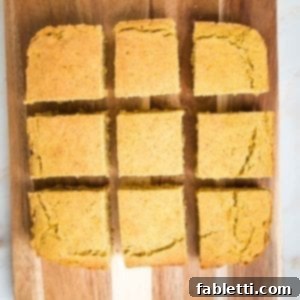
Gluten-free Vegan Cornbread with Puréed Corn Kernels
Author: Debra Klein
Oven-baked vegan and gluten-free cornbread using puréed corn kernels for an irresistibly moist and delicious result. Perfect as a side dish, in your holiday stuffing, or for a quick, wholesome breakfast.
Prep Time: 5 mins
Cook Time: 35 mins
Additional Time: 10 mins (for flax to gel)
Total Time: 50 mins
Course: Side Dish
Cuisine: American
Servings: 9 servings
Calories: 222 kcal per serving
Equipment
- Stainless steel mixing bowls
- Parchment Baking Paper
- 2 Qt Glass Baking Dish with Lid (or 8×8″ square pan)
- Blender
- Colander
- 8-inch Cast Iron Skillet (optional, for crispy edges)
- Offset Spatula (optional)
Ingredients
- 1 16-oz package frozen corn (2 cups), defrosted
- ¼ cup water
- ¼ cup olive oil* (see notes for oil-free option)
- ¼ cup maple syrup or honey* (add 1-2 tbsp more for sweeter cornbread)
- 1 Tablespoon apple cider vinegar
- ⅓ cup ground flax (flaxmeal)
- 1 cup flour* (gluten-free 1-to-1 blend, sprouted spelt, or cassava recommended)
- 1 cup cornmeal (preferably stone ground)
- 2 teaspoons baking powder
- ½ teaspoon baking soda
- ½ teaspoon coarse sea salt
Instructions
- Prepare Wet Mixture: Blend defrosted corn with water and oil in a blender or food processor until completely smooth. Then, add maple syrup, apple cider vinegar, and ground flaxseed, blending again until well combined. Let the mixture sit for 10 minutes to allow the flax to thicken, while you prepare your pan and gather dry ingredients.
- Preheat and Prep Pan: Preheat your oven to 375°F (190°C). Line an 8×8 inch square baking pan with unbleached parchment paper. Alternatively, for a crispy crust, grease an 8-inch cast iron skillet with 1 tablespoon of olive or avocado oil and place it in the oven to heat up while the oven preheats.
- Combine Dry Ingredients: In a medium-sized bowl, whisk together the flour, cornmeal, baking powder, baking soda, and salt until thoroughly combined.
- Mix Batter: Pour the corn mixture into the bowl with the dry ingredients. Mix by hand until the ingredients are JUST COMBINED. Do not overmix; the batter will be very thick and pasty. Ensure all dry ingredients from the bottom of the bowl are incorporated, then stop mixing immediately.
- Bake: Pour the batter into your prepared pan, spreading it evenly with an offset spatula or the back of a spoon. Bake for 35 minutes, or until a toothpick inserted into the center comes out clean and the top is golden and cracked. Baking time may vary by oven (allow 3-5 extra minutes if needed).
- Cool: If you lined your dish with parchment paper, carefully lift the cornbread out and transfer it to a wire rack. Cool completely before cutting into squares to prevent crumbling.
- Store: Store leftover cornbread in an airtight container at room temperature for up to 5 days, in the refrigerator for up to a week, or freeze for up to 3 months.
Notes
- CORN: If you forgot to defrost your frozen corn, simply place it in a colander and rinse it with warm (not hot) water until defrosted and at room temperature.
- SWEETNESS: If you prefer a sweeter cornbread, add an additional 2 tablespoons of maple syrup or your chosen sweetener. The initial amount provides a subtly sweet balance.
- FLOUR: The photos feature gluten-free 1-to-1 flour. This recipe also works well with sprouted spelt (for non-GF), cassava flour (excellent for GF), or whole wheat flour. Use any flour you typically use for baked goods and know you tolerate.
- CORNMEAL: Opt for stone-ground, non-GMO cornmeal if possible. Coarse ground cornmeal will give a grittier texture, while fine ground will result in a smoother cornbread. Choose based on your preference.
- OIL-FREE: To make this recipe oil-free, omit the olive oil and increase the water to ½ cup. Note that this will result in a slightly less moist cornbread, which can be ideal for making stuffing or for dipping into chili.
Nutrition
Serving: 1 slice (approx. 1/9 of loaf)
Calories: 222 kcal
Carbohydrates: 35 g
Protein: 4 g
Fat: 8 g
Saturated Fat: 1 g
Polyunsaturated Fat: 7 g
Sodium: 304 mg
Fiber: 3 g
Sugar: 8 g
The nutrition calculations were done using online tools and are approximate. To obtain the most accurate representation of the nutritional information in any given recipe, you should calculate the nutritional information with the actual ingredients you used. You are ultimately responsible for ensuring that any nutritional information is accurate, complete and useful.
We are confident that this gluten-free vegan cornbread will become a cherished recipe in your home, offering a delicious, moist, and healthy alternative to traditional versions. Its ease of preparation and incredible taste make it a perfect choice for any occasion. If you made this recipe and loved it, please consider leaving a comment and a five-star rating below. We also encourage you to share your beautiful photos on Instagram by tagging me @dkhealthcoach and using the hashtag #debraklein. Your feedback and shares truly help our community grow!
